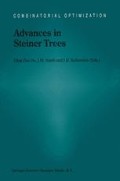Abstract
Many VLSI routing applications, as well as the facility location problem involve computation of Steiner trees with non-linear cost measures. We consider two most frequent versions of this problem. In the power-p Steiner problem the cost is defined as the sum of the edge lengths where each length is raised to the power p > 1. In the bottleneck Steiner problem the objective cost is the maximum of the edge lengths. We show that the power-p Steiner problem is MAX SNP-hard and that one cannot guarantee to find a bottleneck Steiner tree within a factor less than 2, unless P = NP. We prove that in any metric space the minimum spanning tree is at most a constant times worse than the optimal power-p Steiner tree. In particular, for p = 2, we show that the minimum spanning tree is at most 23.3 times worse than the optimum and we construct an instance for which it is 17.2 times worse. We also present a better approximation algorithm for the bottleneck Steiner problem with performance guarantee log2 n, where n is the number of terminals (the minimum spanning tree can be 2 log2 n times worse than the optimum).
Research partially supported by NSF grant CCR-9700053.
Research partially supported by Volkswagen Stiftung and Packard Foundation.
Access this chapter
Tax calculation will be finalised at checkout
Purchases are for personal use only
Preview
Unable to display preview. Download preview PDF.
References
C. D. Bateman, C. S. Helvig, G. Robins, and A. Zelikovsky, ProvablyGood Routing Tree Construction with Multi-Port Terminals, in Proc. International Symposium on Physical Design, Napa Valley, CA, April 1997, pp. 96–102.
K. D. Boese, A. B. Kahng, B. McCoy, and G. Robins, Near-optimal critical sink routing tree constructions, IEEE Trans. on Comput.-Aided Des. of Integr. Circuits and Syst., 14 (1995), pp. 1417–11436.
C. Chiang, M. Sarrafzadeh, and C. K. Wong, Global Routing Based on Steiner Min-Max Trees, IEEE Trans. Computer-Aided Design, 9 (1990), pp. 1318–25.
C. W. Duin and A. Volgenant, The partial sum criterion for Steiner trees in graphs and shortest paths, Europ. J. of Operat. Res., 97 (1997), pp. 172–182.
J. Elzinga, D. Hearn, and W. D. Randolph, Minimax multifacility location with Euclidean distances, Transportation Science, 10 (1976), pp. 321–336.
J. L. Ganley, Geometric interconnection and placement algorithms, PhD thesis, Dept of CS, University of Virginia, 1995.
J. L. Ganley and J. S. Salowe, Optimal and approximate bottleneck Steiner trees, Oper. Res. Lett., 19 (1996), pp. 217–224.
J. L. Ganley and J. S. Salowe, The power-P Steiner tree problem, Nordic Journal of Computing, 5 (1998), pp. 115–127.
G. Hardy, E. Littlewood, and G. Polya, Inequalities, Cambridge University Press, 1934.
N. D. Holmes, N. A. Sherwani, and M. Sarrafzadeh, Utilization of vacant terminals for improved over-the-cell channel routing, IEEE Trans. Computer-Aided Design, 12 (1993), pp. 780–782.
J. N. Hooker, Solving nonlinear multiple-facility network, location problem, Networks, 19 (1989), pp. 117–133.
R. M. Karp, Reducibility among combinatorial problems, in R.E. Miller and J.W. Thatcher. Complexity of Computer Computations, 1972, pp. 85–103.
L. Lovasz and M. Plummer, Matching Theory, Elsvier Science, 1986.
C. H. Papadimitriou and M. Yannakakis, Optimization, approximation, and complexity classes, in Proc. ACM Symp. the Theory of Computing, 1988, pp. 229–234.
M. Sarrafzadeh and C. K. Wong, Bottleneck Steiner trees in the plane, IEEE Trans. on Computers, 41 (1992), pp. 370–374.
J. Soukup, On minimum cost networks with nonlinear costs, SIAM J. Applied Math., 29 (1975), pp. 571–581.
Author information
Authors and Affiliations
Editor information
Editors and Affiliations
Rights and permissions
Copyright information
© 2000 Springer Science+Business Media Dordrecht
About this chapter
Cite this chapter
Berman, P., Zelikovsky, A. (2000). On Approximation of the Power-p and Bottleneck Steiner Trees. In: Du, DZ., Smith, J.M., Rubinstein, J.H. (eds) Advances in Steiner Trees. Combinatorial Optimization, vol 6. Springer, Boston, MA. https://doi.org/10.1007/978-1-4757-3171-2_7
Download citation
DOI: https://doi.org/10.1007/978-1-4757-3171-2_7
Publisher Name: Springer, Boston, MA
Print ISBN: 978-1-4419-4824-3
Online ISBN: 978-1-4757-3171-2
eBook Packages: Springer Book Archive

